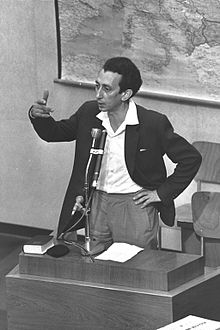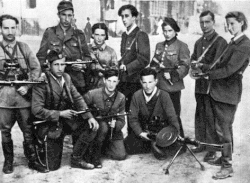Abba Kovner
This article needs additional citations for verification. (December 2023) |
Abba Kovner | |
|---|---|
אבא קובנר | |
 Kovner testifies at the trial of Adolf Eichmann | |
| Born | 14 March 1918 |
| Died | 25 September 1987 (aged 69) |
| Nationality | Polish Israeli |
| Occupation | Poet |
| Notable work | "Let us not go like lambs to the slaughter!" |
| Political party | Mapam |
| Spouse | |
| Children | 2 |
Abba Kovner (
Biography
Abba (Abel) Kovner was born on 14 March 1918 in
World War II

During the 1939 invasion of Poland, Vilnius, where Kovner lived, was occupied by Soviet Union. In 1941, Nazi Germany invaded the Soviet Union and captured Vilnius from the Soviets. All Jews were ordered by the occupiers to move into the Vilna Ghetto, but Kovner managed to hide with several Jewish friends in a Dominican convent headed by Polish Catholic nun Anna Borkowska in the city's suburbs. He soon returned to the ghetto.[3] Kovner concluded that in order for any revolt to be successful, a Jewish resistance fighting force needed to be assembled.
At the start of 1942, Kovner released a manifesto in the ghetto, titled "Let us not go like lambs to the slaughter!",[4] although the authorship has been contested.[5] The manifesto was the first instance in which a target of the Holocaust identified that Hitler had decided to kill all the Jews of Europe, and the first use of the phrase "like sheep to the slaughter" in a Holocaust context. Kovner informed the remaining Jews that their relatives who had been taken away had been murdered in the Ponary massacre and argued that it was best to die fighting.[4] Nobody at that time knew for certain of more than local killings, and many received the manifesto with skepticism.[4] For others, this proclamation represented a turning point in an understanding of the situation and how to respond to it. The idea of resistance was disseminated from Vilnius by youth movement couriers, mainly women, to the ghettos from the now occupied territories of Poland, Belarus and Lithuania.[6]
Kovner, Yitzhak Wittenberg, Alexander Bogen and others formed the Fareynikte Partizaner Organizatsye (FPO), one of the first armed underground organizations in the Jewish ghettos under Nazi occupation.[7] Kovner became its leader in July 1943, after Wittenberg was named by a tortured comrade and turned himself in to prevent an attack on the ghetto.[8] The FPO planned to fight the Germans when they would come to dissolve the ghetto, but circumstances and the opposition of the ghetto leaders made this impossible and they escaped to the forests.[9]
From September 1943 until the return of the Soviet army in July 1944, Kovner, along with his lieutenants
After the Soviet
Nakam
At the end of the war, Kovner was one of the founders of the secret organization
In April 1946, members of Nakam broke into a bakery used to supply bread for the Langwasser internment camp near Nuremberg, where many German POWs were being held. They coated many of the loaves with arsenic but were disturbed and fled before finishing their work. More than 2,200 of the German prisoners fell ill and 207 were hospitalized, but no deaths were reported.[17][19]
Israel
Kovner joined the Haganah in December 1947, and soon after Israel declared independence in May 1948 he became a captain in the Givati Brigade of the IDF.[20] During the 1948 Arab–Israeli War, he became known for his "battle pages", headed "Death to the invaders!", that contained news from the Egyptian front and essays designed to keep up morale.[21] However, the tone of the pages, which called for revenge for the Holocaust and referred to the Egyptian enemy as vipers and dogs, upset many Israeli political and military leaders.[22][23] The leader of HaShomer Hatzair, Meir Ya'ari, accused him of spreading "Fascist horror propaganda."[24] His first battle page, entitled "Failure", started a controversy that still continues today when it accused the Nitzanim garrison of cowardice for surrendering to an overwhelming Egyptian force.[25][26][27]

Ein HaHoresh
From 1946 to his death, Kovner was a resident of Kibbutz
Legacy

Kovner's book of poetry עד-לא-אור ("Ad Lo-Or", English: Until No-Light), 1947, describes in lyric-dramatic narrative the struggle of the Resistance partisans in the swamps and forests of Eastern Europe. Ha-Mafteach Tzalal, ("The Key Drowned"), 1951, is also about this struggle. Pridah Me-ha-darom ("Departure from the South"), 1949, and Panim el Panim ("Face to Face"), 1953, continue the story with the War of Independence.
Kovner's story is the basis for the song "Six Million Germans / Nakam", by Daniel Kahn & the Painted Bird.
Kovner testified about his experiences during the war at the trial of Adolf Eichmann.
Awards and honors
- In 1968, Kovner was awarded the Brenner Prize for literature.[33]
- In 1970, Kovner was awarded the Israel Prize for literature.[34]
- In 1986, Kovner was awarded the Prime Minister's Prize for Hebrew Literary Works.
Further reading
- See ISBN 0-8143-2485-1
- See My Little Sister and Selected Poems, trans. Shirley Kaufman (1986), ISBN 0-932440-20-7
- See ISBN 0-375-40546-1
See also
- Anna Borkowska
- Alexander Bogen
- Bielski partisans
- List of Israel Prize recipients
- Nakam
References
- ^ a b "Where was Abba Kovner born?". www.jmuseum.lt. Retrieved 18 March 2022.
- ^ Joffe, Lawrence (21 June 2003). "Obituary: Meir Vilner". The Guardian. Retrieved 25 January 2015.
- ^ Marcin Masłowski, Tomasz Patora, "Nasz Bóg ich zgubi", Gazeta Wyborcza, 2/6/7 [1]
- ^ a b c Porat, pp56–73.
- ^ "Let Us Not Die as Sheep Led to the Slaughter". Haaretz. 6 December 2007.
- ^ "The Jerusalem of Lithuania: The Story of the Jewish Community of Vilnius – Jewish Responses to the Mass Murder". .yadvashem.org. Retrieved 17 April 2013.
- ^ Porat, pp. 76–105.
- ^ Porat, pp. 126–127.
- ^ Porat, pp. 132–149.
- ^ Porat, pp. 150–175.
- ^ "Information on the Investigation in the Case of Crime Committed in Koniuchy". Institute of National Remembrance. 13 September 2005. Retrieved 24 April 2020.
- ISBN 978-1934843956.
- ^ Porat, pp. 159–160.
- ^ a b c Porat, pp. 210–236.
- ^ Berel Lang (1996). "Holocaust Memory and Revenge: The Presence of the Past". Jewish Social Studies. New Series. 2: 1–20.
- ^ a b Shai Lavi (2005). ""The Jews are Coming": Vengeance and Revenge in post-Nazi Europe". Law, Culture and the Humanities: 282–301.
- ^ ISBN 9780809085637.
- Jweekly.
- ^ "2,283 poisoned in plot against SS prisoners". Miami Daily News. Associated Press. 22 April 1946. Archived from the original on 30 October 2018. Retrieved 7 October 2016.
- ^ Porat, pp. 238–239.
- ^ Porat, p. 244
- ^ Porat, pp. 245–250. "Criticism centered around the harsh, inhumane terms Kovner used to depict the Egyptians, calling them vipers or packs of Nile dogs with dull stupid eyes, whose blood would fill the dry wadi, and whose bodies would serve as food for scavengers."
- ^ Rafi Mann (15 October 2015). "How much must we hate the enemy?". Haaretz.
- ^ Porat, p. 248
- ^ Porat, pp. 250–256.
- ^ Avivai Becker, "The battle still rages – the story of an Israeli war survivor", Haaretz, 25 April 2004.
- S2CID 154459433.
To surrender—so long as the body still lives and the last remaining bullet continues to breathe in its magazine— 'tis a disgrace! To emerge to the invader's captivity—'tis a disgrace and a death!
- ^ Porat, p295.
- ^ a b "Abba Kovner, Israeli Poet, Dies". New York Times. 27 December 1987. Retrieved 24 July 2018.
- ^ Porat, p. 334.
- ^ Porat, pp. 271–294.
- ^ Porat, pp. 335–336.
- ^ "The Brenner Prize – To Abba Kovner". Jpress.org.il (in Hebrew). Davar newspaper. 8 November 1968. Retrieved 15 June 2010.
- ^ "Israel Prize Official Site – Recipients in 1970 (in Hebrew)".
Bibliography
- Dina Porat, The Fall of a Sparrow: The Life and Times of Abba Kovner (Palo Alto, Stanford University Press, 2009). ISBN 978-0804762489.
